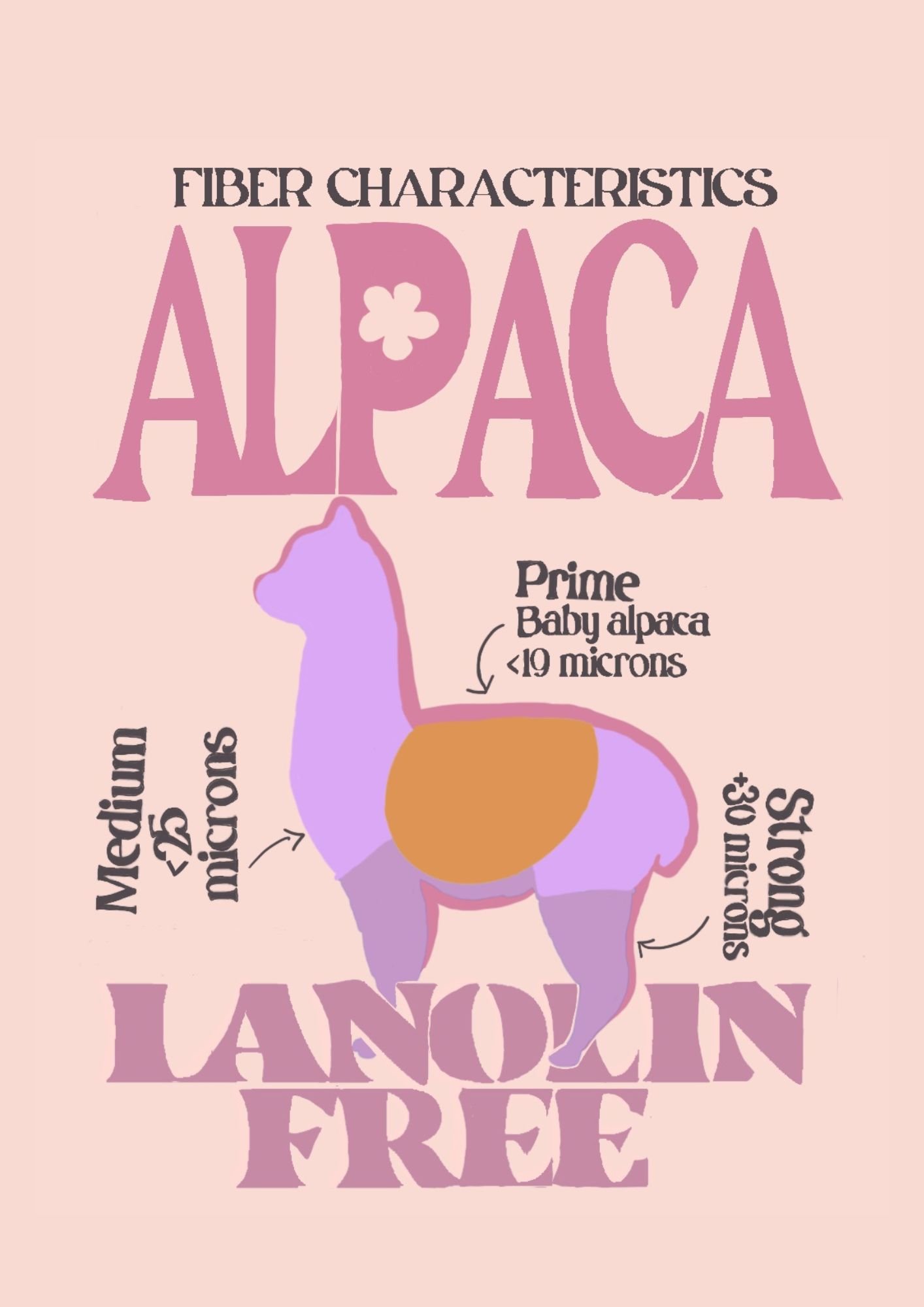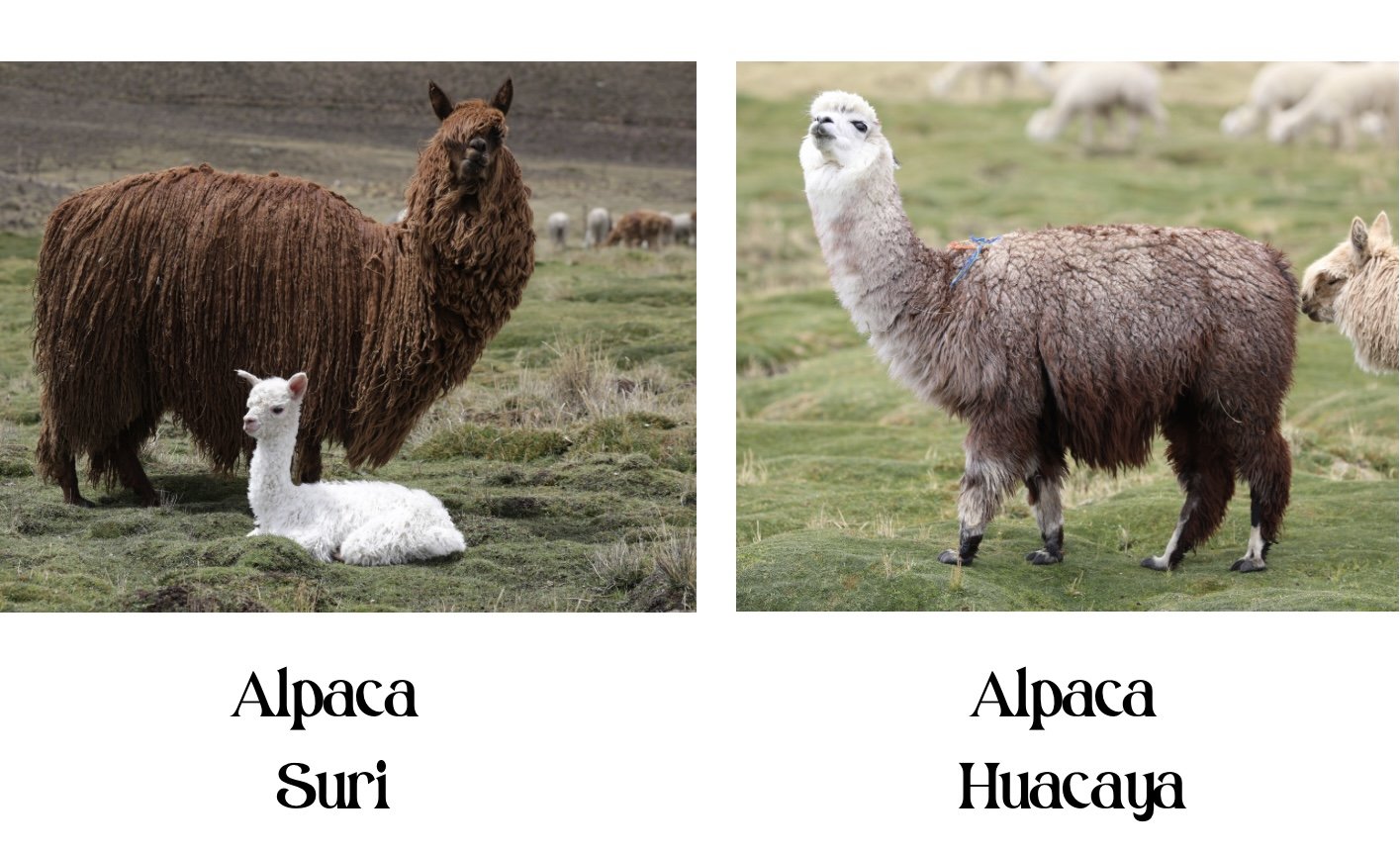What is baby alpaca wool?
Baby alpaca fiber is the finest part of alpaca wool and is hand-selected by women due to their sensitivity and ancestral knowledge. The fineness of the fiber is measured in microns, and the lower the number, the finer and softer the fiber.
We only select the baby quality in alpaca fiber to offer you a unique softness.
Alpaca vs. Cashmere and Other Wool Types
Alpaca fiber has superior thermal properties compared to wool, thanks to its greater number of air pockets within the fiber. It is also hygroscopic, meaning it can absorb moisture from the environment and retain it. This makes it water-resistant and helps maintain dryness against the skin.
Furthermore, alpaca fiber does not contain lanolin, unlike sheep's wool, making it hypoallergenic and avoiding unpleasant reactions for those who are allergic or sensitive. It is also flame-resistant and has a natural luster that gives garments a visually appealing look.
What are the main alpaca breeds?
The two main alpaca species in Peru are the Huacaya alpaca and the Suri alpaca. These are the primary alpaca breeds that produce this precious fiber.
The Huacaya alpaca is the most common breed, representing approximately 90% of the alpaca population. Its fiber is dense, soft, and has a characteristic crimp that gives it a fluffy and voluminous appearance.
On the other hand, the Suri alpaca is less common and represents approximately 10% of alpacas. Its fiber is silky, smooth, and stands out for its shiny and lustrous appearance. The Suri alpaca fiber has a softer and less pronounced crimp pattern compared to that of the Huacaya.
Both the Huacaya and Suri alpacas produce high-quality baby alpaca fiber, with the sought-after characteristics of softness, shine, and strength found in this special fiber.
Shearing of alpacas is carried out annually, usually between the months of October and December in Peru. This allows for a quick assessment of fiber quality and fleece weight, facilitating a more efficient selection program.
Regarding the classification of alpaca fibers, there are different categories, such as Baby Alpaca, which is the finest with a diameter equal to or less than 19 microns and comes from the animal's first shearing. There are also other categories such as Alpaca.
The annual shearing is necessary to maintain the health and well-being of alpacas, as well as to promote proper growth of their fiber.
When are alpacas sheared in Peru?
How much wool does an alpaca produce?
An alpaca can produce a significant amount of wool in a year. On average, an adult alpaca can generate between 2 and 5 kilograms of fiber in a single shearing. However, it is important to note that the exact amount of wool produced by an alpaca can vary depending on various factors such as genetics, quality of nutrition, climate, and care given to the animal.
Furthermore, it is important to mention that baby alpaca fiber, which refers to the finest part of the wool, is typically obtained from the first shearing of a young alpaca, around 1 year old. At this stage, the quantity of baby alpaca fiber produced may be lower compared to a fully grown adult alpaca.
In summary, an alpaca can produce between 2 and 5 kilograms of wool in a single annual shearing, and the amount of fiber can vary depending on various factors. Regular and proper shearing is important for the well-being of alpacas and to obtain an optimal quantity of high-quality wool
Who raises alpacas in Peru?
In Peru, it is worth mentioning that nearly 80% of alpaca fiber comes from the country. This highlights the significance of alpaca farming and fiber production in this region. The favorable climatic conditions and environment in this geographical area promote the growth of high-quality alpaca fiber.
It is important to note that approximately 70% of alpacas are raised by small families of alpaca breeders. These breeders have an average herd size of around 50 alpacas. These families primarily dedicate themselves to alpaca farming for the production of alpaca fiber, which is highly valued for its softness, warmth, and other properties.
These small breeders play a crucial role in the preservation and promotion of traditional alpaca farming in Peru. Their ancestral knowledge of alpaca care and management is passed down through generations, contributing to the maintenance of the quality and authenticity of Peruvian alpaca fiber. Through their work, these alpaca breeding families generate income for their households and contribute to the sustainable development of rural communities where they reside. Their activity also promotes biodiversity conservation and preserves the Andean ecosystems, where alpacas adapt and thrive.
Unfortunately, it is true that many alpaca breeders are not adequately compensated when selling their fiber. Often, they are paid solely for the raw fiber without considering its quality or origin. This can result in undervaluing their work and the alpaca fiber itself.
This precious alpaca fiber is widely exported to Asia and Europe to be industrially processed and manufactured. Unfortunately, during this process, its true value is often overlooked. The fiber selection may not be stringent, leading to the presence of average or coarse quality fibers that can feel rough to the touch. Regrettably, this contributes to a negative reputation for this magnificent wool.
That is precisely why we strive to produce all our products directly at the source, working closely with alpaca breeders. By avoiding intermediaries and international wholesalers, we can ensure fair compensation for the breeders and emphasize the entire artisanal chain.
By supporting alpaca breeders and highlighting their expertise, we contribute to preserving an ancestral tradition and maintaining a sustainable economic balance for rural communities that rely on alpaca farming. Additionally, by controlling every step of the production process, from fiber to the creation of finished products, we can ensure the quality and authenticity of our alpaca items.
We firmly believe that valuing the entire artisanal chain, from the work of the breeders to the craftsmanship of the artisans creating the products, is essential to preserving the richness and uniqueness of alpaca fiber. This is how we can offer high-quality products that reflect the true heritage of alpaca and support an ethical and sustainable economy.
Why don't alpacas degrade the soil like sheep do?
Alpacas, on the other hand, have a grazing behavior where they bite off the vegetation without uprooting it. This grazing style is gentler on the soil, as the plants are not completely removed, allowing them to regrow more easily. Additionally, alpacas have padded feet with soft toenails, which have a minimal impact on the ground compared to the hooves of sheep, which can be more damaging to the soil structure. These factors contribute to alpacas having a lesser impact on soil degradation compared to sheep.
However, alpacas are gentler grazers. They use their lower lips and teeth to cut the grass close to the ground, leaving the roots intact. This grazing method preserves the soil structure and promotes grass regrowth. Additionally, alpacas have soft pads on their feet, which reduces their impact on the soil and prevents damage.
Thanks to these specific grazing habits, alpacas contribute to preserving soil balance by avoiding soil degradation. This makes them well-suited to delicate environments such as the high Andean plateaus, where they originate from.
Alpacas have pads under their feet, which distinguishes them from sheep, who have hooves. These pads provide several advantages to alpacas and contribute to soil preservation. Unlike the hard hooves of sheep that can cause damage by digging and compacting the soil, the soft pads of alpacas reduce their impact on the environment.
The alpacas' pads act as natural shock absorbers by evenly distributing their weight over a larger surface area. This minimizes the pressure exerted on the soil, reducing the risk of compaction and soil degradation. Additionally, the soft texture of alpacas' pads limits physical damage to the surfaces they walk on.
Thanks to their pads, alpacas can move with great agility on different types of terrain, including delicate and fragile soils. This anatomical adaptation allows them to preserve the balance and health of the ecosystems they inhabit, promoting biodiversity and land sustainability.
En résumé, les coussinets des alpagas sont une caractéristique unique qui les distingue des moutons. Ces coussinets souples protègent les sols en réduisant leur impact et en évitant les dommages causés par le piétinement. Cette adaptation naturelle contribue à préserver la santé des écosystèmes où les alpagas évoluent, faisant d'eux des animaux respectueux de l'environnement.














